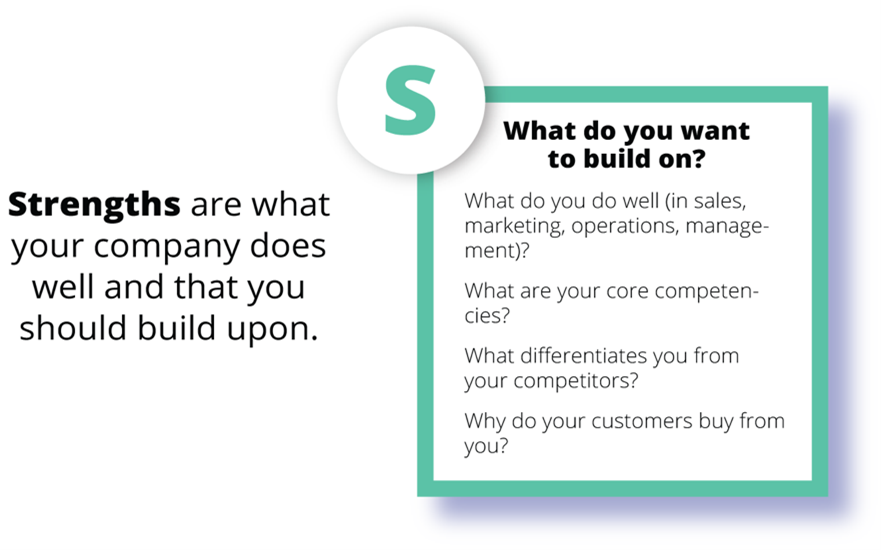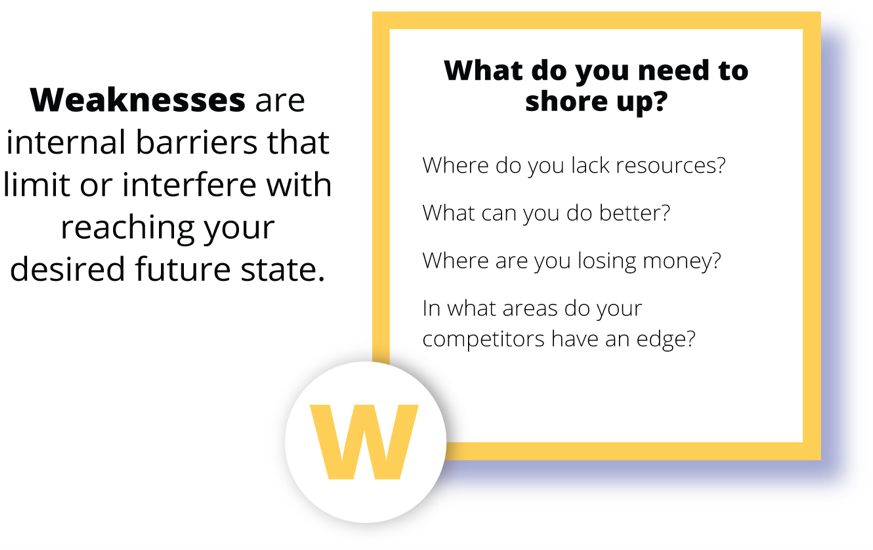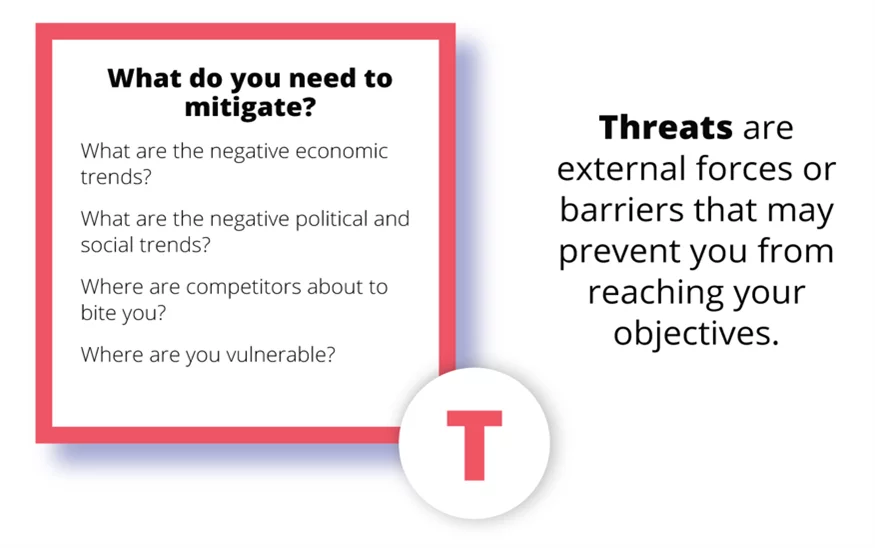A Refresher on SWOT
SWOT stands for Strengths, Weaknesses, Opportunities, and Threats. The purpose of a SWOT analysis is to objectively review what your organization is and isn’t doing well to create a synthesized view of the current state of your organization. This article will further help you on how to do a SWOT analysis. But, if you need a refresher, be sure to read our introductory post here!
Excellent strategic planning begins with a keen understanding of where you are today to build a bright and prosperous future. A key concept to remember is identifying the attribute and its impact, be it positive or negative.
A SWOT analysis is a great way to identify, organize, and fully determine your current state.
We’ll discuss what it is in more detail, how to pull it all together, and then most importantly, explain how to effectively put it to use while you have the momentum to do so.
How to Do a SWOT Analysis in 5 Steps
Step 1: Gather the Data You Need Internally and Externally
A SWOT analysis, by definition, is designed to look at the internal and external forces that hinder or enable your organization and what market forces you need to seize or mitigate. Need help with your SWOT? Use this SWOT template with examples!
A complete SWOT analysis requires examining internal and external data to create a holistic assessment of your organization’s current state.
Pro Tip –
Without data, a SWOT can be filled with opinions instead of data and facts. You can lean into your team’s opinions, but they shouldn’t be the sole basis for your SWOT. Lean on good data.
Internal Data Sources
- Past 3 Years Revenue & Next 3- to 5-Year Forecast – Revenue by customer segment, revenue by product line/service offering.
- Profitability – Operating costs, EBITDA by line of business or market.
- Marketing Performance – Web traffic analytics, keyword reports, earned and paid media performance and for a few share-of-voice might be a data point you capture.
- Sales Performance and Pipelines – Closed business, pipeline forecast, time to close.
- Staff Insights – Including employee engagement/satisfaction, product or service delivery performance.
- Customer Insights & Customer Analytics – Log in sessions, time spent using product, average customer value, customer satisfaction/ratings and needs, customer surveys.
External Data Sources
- Consumer Data – Demographics, media consumption, social media usage, consumer behavior.
- Labor Markets – Labor forecasts, labor market size, labor growth or reduction.
- Economic Forecasts – Market sizing, market growth, consumer spending forecasts.
- Marketing Data – Addressable search traffic, addressable audience sizes, industry CPC or CPA averages.
- Competitor Data – From industry reports, marketing data available, or review sites.
- Supply Chain Data – Lead times, availability of a product for manufacturing, shipping routes or times.
- Local Data – Growth or reduction in metros, population by zip code, demographics by zip code.
- Real Estate – Forecasted commercial/residential values, market forecasts for rent, affordability indexes.
Get the Free Guide and Canvas to Create a SWOT Analysis
Step 2: Assess Your Internal Strengths

Look within and focus on the experience and resources you have today that you can further develop and lean on for continued success.
Pro Tip –
Your growth strategy and competitive advantages start here. You need to know what you do well today to determine how it will play into your approach to growth and if the unique strengths you possess are your competitive advantages.
Questions to ask to help identify your organization’s strengths?
- What are your core competencies?
- What differentiates you from your competitors? What do you do better than your competitors?
- Why do your customers buy from you?
- What do you do well in marketing, sales, or operations?
- Do you have any strengths financially?
- Do you have strengths in your customer service?
Example Data Sources and Ideas for Strengths
- What positive feedback have you received from your customers? Are those strengths?
- What do your employees say during assessments or surveys about your organization’s strengths?
- NPS scores can help identify strengths.
- What does your internal data tell you about your current strengths? How do you perform well in marketing, sales, financial management, position, or operations?
Step 3: Assess Your Internal Weaknesses

This can feel like a vulnerable, critical part of completing your SWOT analysis because it requires a level of self-criticism and honesty that can be daunting – but remember, it can be a rewarding exercise if done with objectivity and clarity. You get the chance to identify what’s not working in your organization and how you might address those issues to better support your vision and mission.
Pro Tip –
You’ll need to take a step back and be vulnerable and honest about your weaknesses. If you are honest, you’ll be able to create strategies or initiatives to solve your organization’s biggest weaknesses.
Questions to Answer
- Where do you lack resources?
- What can you do better?
- Where are you losing money?
- In what areas do your competitors have an edge?
Example Data Sources and Areas to Look for Weaknesses
- Negative feedback received from customers.
- Critical feedback from employee assessments or surveys.
- Draws on your NPS scores.
- Looking at employee turnover rates and exit interviews.
- Company workflows and efficiency rates.
- Operational inefficiencies, dragging profitability, or overhead costs.
Step 4: Assess Your External Opportunities

Finding opportunities based in your market takes research, a bit of creativity, and skill. It’s about finding external market opportunities that your organization is well positioned to take advantage of, and sometimes it requires thinking outside of the box.
Opportunities rely solely on external sources, which requires digging and finding good data sources to review your market. And because it’s based on external data, it can be a more challenging section of your SWOT. But it can be refreshing to complete this section in your SWOT because you get to see the world through the lens of an optimist. You’ll get to examine economic and market trends, environmental concerns, and political/governmental regulations that could propel your organization to your desired future state.
Pro Tip –
The world is in a constant state of change. When assessing your market opportunities, look for current data and emerging market trends. A market report from 3 years ago might still be relevant but be critical about your sources. Current data is important.
Questions to Answer:
- What are the needs of your customers currently unmet by your organization? Are you positioned to meet those needs?
- Are there economic trends you might capitalize on?
- What are the emerging political and social opportunities that you need to capitalize on?
- What niches have your competitors missed in the marketplace?
Example Data Sources to Consider
- Are there any opportunities within changing consumer habits you can capitalize on?
- Economic forecasts for your geography or industry.
- Holes in the market your competitors have missed.
- Opportunities to change or modify your supply chain for your benefit.
- Political or governmental forces to benefit from.
- What political or governmental forces could you benefit from?
- How could the change in real estate benefit your organization?
- How can you play the shifting global economy to your advantage?
Step 5: Assess Your External Threats

Threats are external factors out of your control that can hurt your organization. A threat is not a weakness; those are internal factors that you can generally solve with intention. A threat must be identified to reduce the risk of harm or mitigate possible damages.
Pro Tip –
Threats can be mitigated, sometimes. In other cases, it’s just something you need to watch closely and respond to when necessary.
Questions to Answer
- What negative economic trends do you need to mitigate?
- What are negative political or social trends you need to address?
- Where are competitors about to bite you?
- Where are you vulnerable?
- What other external forces do you need to mitigate?
Example Data Sources to Consider
- Disruptions in the global supply chain could threaten your businesses.
- Threats in your competitive environment from new or emerging competitors.
- Shifts in your target audiences.
- Changes in technology threaten your competitive advantages.
- Shifting economic forecasts that are not in your favor.
- Increasing costs of living for your employees.
- Rising real estate prices impacting your organization’s rent.
- Tight labor markets make it challenging to attract talent.
How You Know You Got it Right
Standing back and addressing your current state requires digging deep, getting a bit uncomfortable, and thinking hard about where your organization currently stands today.
Here’s the checklist of an awesome SWOT analysis:
- Does your SWOT contain all the key areas relevant to your plan? This needs to include insights about customers, employees, leadership, competitors, industry trends, and external market forces.
- Does each item in your SWOT identify the attribute and the impact?
- Is each item under strengths and weaknesses internal and controllable?
- Are the items under opportunities and threats external and not controllable?
- Were you honest about the potential threats and dug deep enough to find the ones you may not want to see?
You’ve Done Your SWOT? What’s Next?
Now that you’ve done the heavy lifting, how do you make sure your hard work isn’t in vain? You use what you’ve got to get what you want, which is a roadmap to success. The most important thing is to use your SWOT to turn the information into goals, actions, and other elements of your strategic plan.

Strengths – Create Goals & Identify Competitive Advantages
The strengths section of a SWOT helps create a few specific outputs. The first of which is to help create goals and actions for your team to build upon your strengths.
The second output of your strengths is to help your organization identify its competitive advantages. We’ve covered this extensively in our competitive advantages post and guide, so check that out here!
Examples of Strengths
- How do you build upon your strong brand reputation?
- How can you continue to have high staff retention and build an amazing culture? Could a Diversity, Equity, and Accessibility initiative help create an inclusive culture?
- If you have great marketing presence, what can you do to improve it even further?
Weaknesses – Pick Urgent and Important Themes to Address
The weaknesses section helps your organization identify clear areas of improvement. The key here is that you need to decide what is most important or urgent to act upon, and then create goals or actions in your plan to address these weaknesses.
Looking at your weaknesses, it is entirely within your ability to control and change them, so you can create initiatives to solve areas of concern. It is recommended to start with the most pertinent and then work your way through the list from there.
Examples to Show How to do a SWOT Analysis
- If you have high turnover and unhappy employees, examine what can be done to change behaviors, outcomes, and improve your culture. Identify key areas of concern and make commitments to shifting that methodology or behavior.
- Examine work processes and determine how to make things simpler.
- Invest in employee learning and development to increase their value both intrinsically and to the organization.
- Examine your physical real estate and determine the need for it in relation to a remote work environment, or you can make changes like reconfiguring, growing, or downsizing your office space.
Opportunities – Prioritize Your Opportunities, Build a Growth Strategy
Examine your opportunities and create short-term and long-term goals focusing on how to strategically go after them to win more business or benefits for your organization.
Your external opportunities paired with your competitive advantages are what feed your growth strategy. Check out our post and guide on building your growth strategy!
Pro Tip –
Have too many opportunities and not sure what you need to prioritize? Check out our guide on prioritizing opportunities.
Threats – Watch, and Refresh them Quarterly
In most cases, your SWOTs won’t have a significant number of threats, but look at the few you do have as an opportunity to create proactive initiatives.
If you don’t need to create proactive initiatives, it is best to review and refresh them quarterly to see if anything is an emerging threat.
Final Reminder – If You Create a SWOT, Use It!
Last tip, whatever you do, do not go through the exercise of putting your SWOT together and then fail to put it to good use. We see that ALL the time. Make sure you use your SWOT to build out your goals and your competitive advantages to set yourself apart and create a winning roadmap for success. Happy strategizing!
Frequently asked questions
Still not sure how to conduct a SWOT analysis? Read our Frequently Asked Questions for more clarity.
OnStrategy recommends five tips to help you easily and thoughtfully develop your own SWOT analysis:
- Use clear, verifiable, and quantifiable data to form your SWOT- not just opinions.
- Be clear and write complete sentences, not just singular words. For example, instead of citing ‘recruitment’ as a weakness, instead explain ‘Open positions take three or more months to fill’…
- Only include entries that lead to action
- If internal opportunities are also identified, be sure to separate the internal opportunities from the external opportunities. Keep it clear and concise, not convoluted!
- Engage multiple levels of the organization to create your SWOT, not just your executive team.
A PESTLE analysis can serve as a great alternative or addition to your SWOT analysis. It looks at the various environmental/external forces your organization may come up against such as political, economic, sociological, technological, legal, and environmental forces that can prove as either threats or opportunities to your business.
Fixing the cta placement












